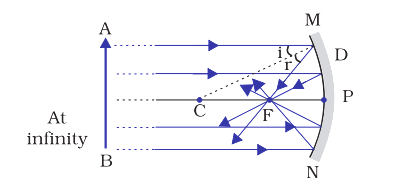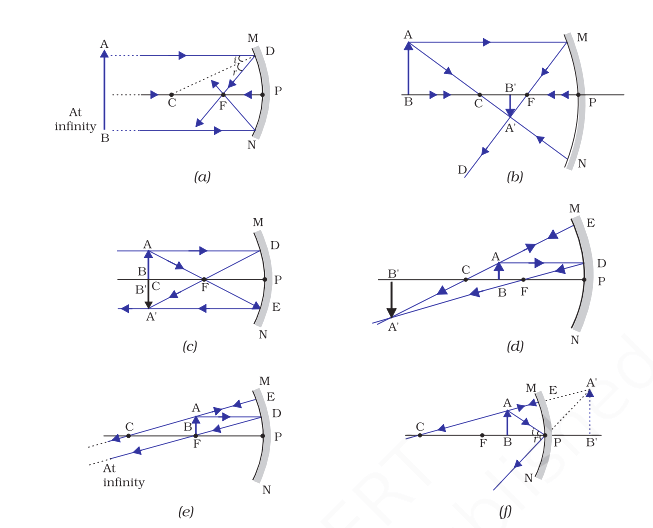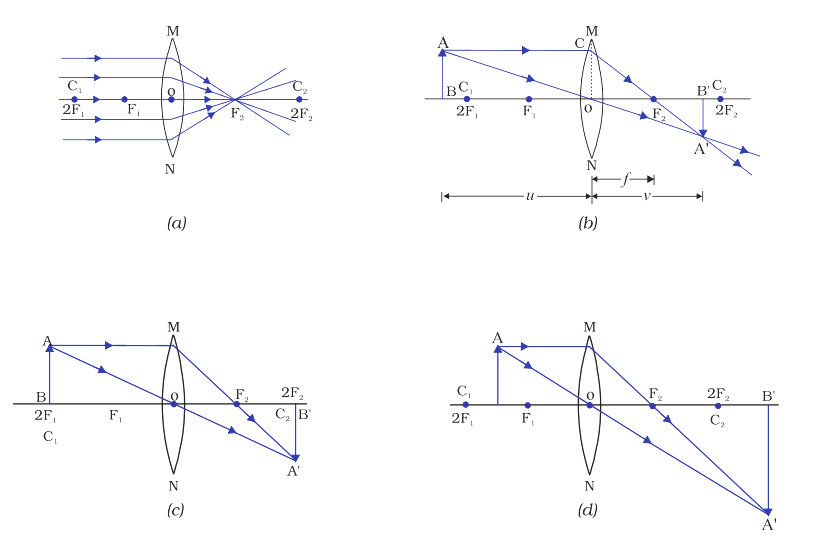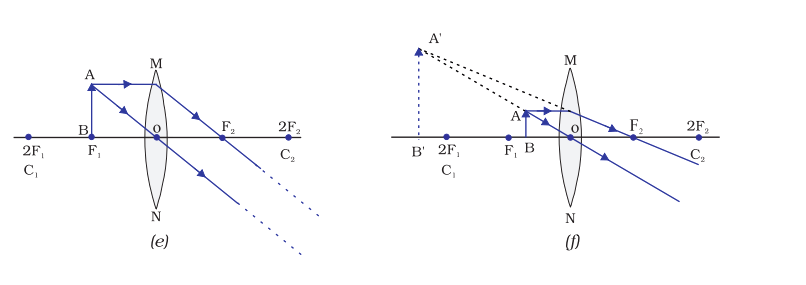NCERT Class 10 Science Chapter 9 Light : Reflection and Refraction Notes Solution For School Students of Class 10th. We also Provides Notes and Important Questions for Class 10 Science. NCERT Class 10th Science book is applied in mostly boards like CBSE, HBSE, RBSE, Up Board, MP Board and also some other state boards.
- Also Read:- Class 10 Science NCERT Solution
- Also Read – Class 10 Important Questions
NCERT Class 10 Science Chapter 9 Light : Reflection and Refraction Notes for CBSE, HBSE, RBSE, UK Board, HP Board, MP Board and Other Boards Solution.
Light : Reflection and Refraction Class 10 Science Chapter 9 Notes
Reflection of light : It is the process of bouncing back of light rays when it strikes the highly polished surface such as mirror.
Laws of Reflection : (i) The angle of incidence is equal to the angle of reflection, and
(ii) The incident ray, the normal to the mirror at the point of incidence and the reflected ray , all lie in the same plane.
Types of Mirror
(i) Plane Mirror :
- Size of image is equal to the size of object.
- Nature of image : virtual and erect
- Image formed is as far behind the mirror as the object is in front of it.
- Image is laterally inverted.
- Focal length of plane mirror is infinity.
(ii) Spherical Mirror : Those mirrors, whose reflecting surfaces are spherical, are called Spherical mirrors.
Depending upon reflecting surfaces, spherical mirrors are two types :
- Concave mirror : A spherical mirror, whose reflecting surface is curved inwards.
- Convex mirror : A spherical mirror, whose reflecting surface is curved outwards.
Some General Terms
- Pole (P) : The centre of the reflecting surface of a spherical mirror is a point called pole. It lies on the surface of mirror.
- Centre of Curvature (C) : The reflecting surface of a spherical mirror forms a part of a sphere. This sphere has a centre. This point is called the centre of curvature. For concave mirror it lies in front of mirror and for convex mirror it lies behind the mirror.
- Radius of sphere (R) : The radius of sphere of which the reflecting surface of a spherical mirror forms a part, is called radius of sphere. It is the distance between centre of curvature and pole.
- Principal axis : A straight Imaginary line passing the pole and the centre of curvature of spherical mirror is called principal axis.
- Principal Focus (F) : A number of rays parallel to principal axis after reflection meets at a point on principal axis. This point is called principal focus.
- Focal length (f) : The distance between the pole and the principal focus of a spherical mirror is called the focal length.
- Aperture : The diameter of the reflecting surface is called its aperture.
- Important relation : R = 2f

In the given fig.
MN is aperture, P is pole, C is centre of curvature, Distance between C and P is Radius of sphere, F is principal focus, distance between F and P is focal length.
Image Formation by Spherical mirrors
(i) Image formed by Concave Mirror :
Image formed by concave mirror can be real and inverted or virtual and erect depending upon the position of object.
| S.No | Position of the object | Position of the image | Size of the image | Nature of the Image |
| (a) | At infinity | At the Focus F | Highly diminished, point-sized | Real and inverted |
| (b) | Beyond C | Between F and C | Diminished | Real and inverted |
| (c) | At C | At C | Same size | Real and inverted |
| (d) | Between C and F | Beyond C | Enlarged | Real and inverted |
| (e) | At F | At infinity | Highly enlarged | Real and inverted |
| (f) | Behind the mirror | Behind the mirror | Enlarged | Virtual and erect |

Uses of Concave Mirror :
- Concave mirrors are commonly used in torches, search-lights and vehicles headlights to get powerful parallel beams of light.
- They often used as shaving mirrors to see a large image of face.
- Dentists use concave mirrors to see large images of the teeth of patients.
- Large concave mirrors are used to concentrate sunlight to produce heat in solar furnaces.
(ii) Image formed by Convex Mirror
Image formed by Convex mirror will always be virtual and erect.
| S.No | Position of the object | Position of the image | Size of the image | Nature of the Image |
| (a) | At infinity | At the focus F, behind the mirror | Highly diminished, point-sized | Virtual and erect |
| (b) | Between infinity and the pole P of the mirror | Between P and F, behind the mirror | Diminished | Virtual and erect |

Uses of convex mirrors :
- Convex mirrors are commonly used as rear-view (wing) mirrors in vehicles. These mirrors are fitted on the sides of the vehicles, enabling the driver to see the traffic behind him/her to facilitate the safe driving. Convex mirror always give erect and diminished image and give wider view as they are curved outwards.
- It is used in ATMs for security purposes
- It is also used as a reflector for street lights.
Some key point regarding image formation by Spherical Mirrors
(i) A ray parallel to the principal axis, after reflection, will pass through the principal focus in case of concave mirror or appear to diverge in case of convex mirror.
(ii) A ray passing through the principal focus of a concave mirror or is directed towards principal focus of a convex mirror after reflection , will emerge parallel to the principal axis.
(iii) A ray passing through the centre of a concave mirror or directed in the direction of centre of curvature of a convex mirror, after reflection, is reflected back along the same path.
(iv) A ray incident obliquely to the principal axis towards point P (pole of mirror), on the concave or convex mirror, is reflected obliquely.
Sign Convention for Reflection by Spherical Mirrors

Mirror Formula
Where, v (image distance) : The distance of image from its pole.
u (object distance) : The distance of object from its pole.
f (focal length) : The distance of principal focus from the pole.
Note : Focal length is positive for convex mirror and negative for concave mirror. Similarly focal length is positive for convex lens and negative for concave mirror.
Magnification
It is expressed as the ratio of the height of the image to the height of the object. It is usually represented by letter m.
Magnification is positive for virtual images and negative for real images. It means magnification for convex mirror is positive and magnification for concave mirror can be positive or negative depending upon the nature of image.
Refraction of light : The change in direction of light, when it travels from one medium to another medium is called refraction of light. A light ray travelling obliquely from a denser medium to a rarer medium bends away from the normal. A light ray bends towards the normal when it travels obliquely from a rarer to a denser medium.
Some day-to-day examples of refraction of light :-
- The bottom of a tank or a pond containing water appears to be raised.
- When a thick glass slab is placed over some printed matter, the letters appear raised when viewed through glass slab.
- A pencil immersed in water in a glass.
Law of Refraction of light :
(i) The incident ray, the refracted ray and the normal to the interface of two transparent media at the point of incidence, all lie in the same plant.
(ii) The ratio of sine of angle of incidence to the sine of angle of refraction is constant, for the light of a given colour and for the given pair of media. This law is also called snell’s law.
, 0<i<90°
Refractive Index : The extent of the change in direction of light ray when it travel from one medium to another is expressed in terms of refractive index.
Refractive index of transparent medium = Speed of light in vacuum / speed of light in medium
Speed of light in vacuum = 3 × 108 ms-1
Refraction through spherical Lenses
Lens : A transparent material bound by two surfaces, of which one or both surfaces are spherical, forms a lens.
Convex Lens : A lens having two spherical surfaces bulging outside. It is thicker at the middle as compared to edge. It is also called converging lens.
Concave lens : A lens having two spherical surfaces curved inwards. it is thicker at the edge as compared to middle. It is also called diverging lens.
- The central point of a lens is called its optical centre (O) .
- Lenes have two centre of curvature C1 and C2,
- A lens has two principal foci represented by F1 and F2
Image formed by Lenses
(i) Image formed by Convex Lens
| S.No | Position of the object | Position of the image | Size of the image | Nature of the Image |
| (a) | At infinity | At the Focus F2 | Highly diminished, point-sized | Real and inverted |
| (b) | Beyond 2F1 | Between F2 and 2F2 | Diminished | Real and inverted |
| (c) | At 2F1 | At 2F2 | Same size | Real and inverted |
| (d) | Between F1 and 2F1 | Beyond 2F2 | Enlarged | Real and inverted |
| (e) | At focus F1 | At infinity | Highly enlarged | Real and inverted |
| (f) | Between focus F1 and optical centre O | On the same side of the lens as the object | Enlarged | Virtual and erect |


(ii) Image formed by Concave Lens
| S.No | Position of the object | Position of the image | Size of the image | Nature of the Image |
| (a) | At infinity | At the focus F1 | Highly diminished, point-sized | Virtual and erect |
| (b) | Between infinity and optical centre O of the lens | Between focus F1 and optical centre O | Diminished | Virtual and erect |

Lens Formula
Where, u = object distance, v image distance and f is focal length of a spherical lens.
Magnification of lens =
Power of a Lens (P)
The degree of convergence or divergence of light rays achieved by a lens in expressed in terms of its power. The power of a lens is defined as the reciprocal of its focal length.
P =
SI unit of power is dioptre (D).
1D = 1 m-1
- Power of convex lens is positive (as focal length of convex lens is positive)
- Power of concave lens is negative (as focal length of concave lens is negative)
Other Important facts :
- Refractive index of Air is 1.
- Refractive index of water is 1.33.
- Refractive index of diamond is 2.42